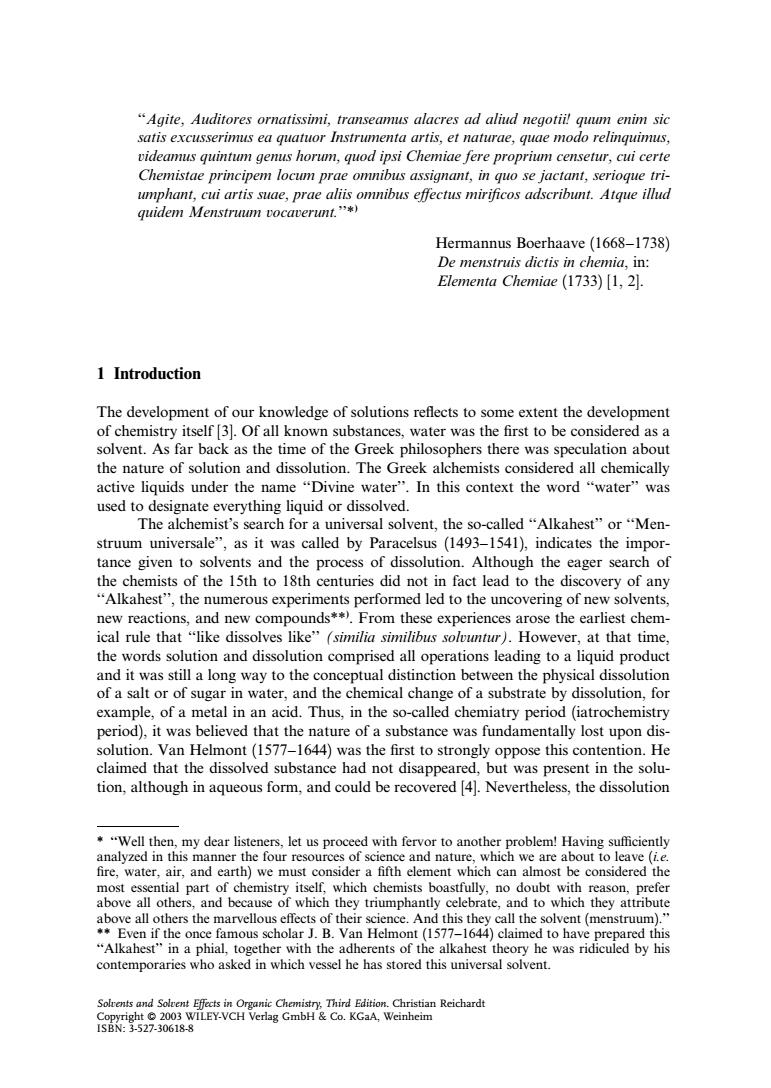正在加载图片...

"Agite,Auditores ornatissimi,transeamus alacres ad alind negoti um enim sic satis excusserimus ea quatuor Instrumenta artis,et naturae,quae modo relinquimus cideamus quintum genus horum,quod ipsi Chemiae fere proprium censetur,cui certe Chemistae principem locum prae omnibus assignant,in quo se jactant,serioque tri- pncis se,praeombueetu mirificos adscribuAtqueld quidem Menstruum tocaverunt. Hermannus Boerhaave(1668-1738) De menstruis dictis in chemia,in: Elementa Chemiae (1733 [1,21. 1 Introduction The develo nt of our knowledge of solutions reflects to self(31 of all l the extent the develo olvent as far hack a the tir re the solutio and dis solution. The Greek alch mists d all ch nde th In this contex he word was or diss lvent the called“Alkahest'”or“"Men vers as it called by 493-1541 dicates the give A the 15th to 18 centune id f any umerous exper ns,and n nds perforn rom th u tha like dis How words sol and dissolution comprised all operat ng to a iquid produc and it was still a long way to the conceptual distinction between the physical dissolution of a salt or of sugar in water,and the chemical change of a substrate by dissolution. example,of a metal in an acid.Thus,in the so-called chemiatry period (iatrochemistry period).it was believed that the nature of a substance was fundamentally lost upon dis solution Van Helmont (1577-1644)was the first to strongly oppose this contention.He claimed that the dissolved substance had not disappeared but was present in the solu- tion,although in aqueous form,and could be recovered [4].Nevertheless,the dissolution my dear lis let us proceed with fire.water,air,and earth)we must cons r a fifth element which can almost be considered th of which they tium ent(menstruu in a phial t er with the adhe e alkahest the he to as ridiculed by his contemporaries who asked in which vessel he has stored this universal solvent ‘‘Agite, Auditores ornatissimi, transeamus alacres ad aliud negotii! quum enim sic satis excusserimus ea quatuor Instrumenta artis, et naturae, quae modo relinquimus, videamus quintum genus horum, quod ipsi Chemiae fere proprium censetur, cui certe Chemistae principem locum prae omnibus assignant, in quo se jactant, serioque triumphant, cui artis suae, prae aliis omnibus e¤ectus mirificos adscribunt. Atque illud quidem Menstruum vocaverunt.’’*) Hermannus Boerhaave (1668–1738) De menstruis dictis in chemia, in: Elementa Chemiae (1733) [1, 2]. 1 Introduction The development of our knowledge of solutions reflects to some extent the development of chemistry itself [3]. Of all known substances, water was the first to be considered as a solvent. As far back as the time of the Greek philosophers there was speculation about the nature of solution and dissolution. The Greek alchemists considered all chemically active liquids under the name ‘‘Divine water’’. In this context the word ‘‘water’’ was used to designate everything liquid or dissolved. The alchemist’s search for a universal solvent, the so-called ‘‘Alkahest’’ or ‘‘Menstruum universale’’, as it was called by Paracelsus (1493–1541), indicates the importance given to solvents and the process of dissolution. Although the eager search of the chemists of the 15th to 18th centuries did not in fact lead to the discovery of any ‘‘Alkahest’’, the numerous experiments performed led to the uncovering of new solvents, new reactions, and new compounds**). From these experiences arose the earliest chemical rule that ‘‘like dissolves like’’ (similia similibus solvuntur). However, at that time, the words solution and dissolution comprised all operations leading to a liquid product and it was still a long way to the conceptual distinction between the physical dissolution of a salt or of sugar in water, and the chemical change of a substrate by dissolution, for example, of a metal in an acid. Thus, in the so-called chemiatry period (iatrochemistry period), it was believed that the nature of a substance was fundamentally lost upon dissolution. Van Helmont (1577–1644) was the first to strongly oppose this contention. He claimed that the dissolved substance had not disappeared, but was present in the solution, although in aqueous form, and could be recovered [4]. Nevertheless, the dissolution * ‘‘Well then, my dear listeners, let us proceed with fervor to another problem! Having su‰ciently analyzed in this manner the four resources of science and nature, which we are about to leave (i.e. fire, water, air, and earth) we must consider a fifth element which can almost be considered the most essential part of chemistry itself, which chemists boastfully, no doubt with reason, prefer above all others, and because of which they triumphantly celebrate, and to which they attribute above all others the marvellous e¤ects of their science. And this they call the solvent (menstruum).’’ ** Even if the once famous scholar J. B. Van Helmont (1577–1644) claimed to have prepared this ‘‘Alkahest’’ in a phial, together with the adherents of the alkahest theory he was ridiculed by his contemporaries who asked in which vessel he has stored this universal solvent. Solvents and Solvent Effects in Organic Chemistry, Third Edition. Christian Reichardt Copyright 8 2003 WILEY-VCH Verlag GmbH & Co. KGaA, Weinheim ISBN: 3-527-30618-8